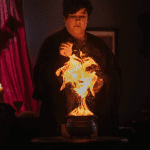A tomte is a Swedish spirit from Nordic folklore who is associated with Yule and later Christmas. Tomte translates to “homestead man” and his Norwegian counterpart the Nisse comes from the word Nils which is a form of the name Nicholas (like St. Nicholas) in Scandinavia, though some theories link it to the word niðsi (“dear little relative”). The tomte is similar to appearance and statue of the average garden gnome at about two feet tall and is depicted as an elderly man with a long beard, tattered clothing usually in grey, blue, or red and a red cap. The tomte was in charge of the farmwork including protecting and raising the animals, clearing forest land, and caring for the growth of livestock. Despite his size, he was attributed to incredible strength and stamina. Some theories believe that he may be the remnant of older ancestral reverence practices, particularly with the Nisse name theory, and that he was the ancestral spirit of an older farmer on that land. The connection between ancestral spirit and spirits in the fae is a very strong connection in Europe.
The tomte had an affinity for horses and it was believed that the healthiest horse would be the one the tomte favored and was looking after, often braiding the horse’s mane and tail himself. This cute little horse-loving and hard working spirit was a great ally to have around the house and farm. As such the tomte asked for very little. The only payments that were required of the tomte were to trust the spirit, have manners around the farm, display teamwork on the farm and around the house, respect the tomte, treat your animals well, and one meal of porridge with butter on the Winter Solstice or Christmas Night (depending on the era).
However, the tomte also had a darker side as almost all spirits do. If you disrespected or offended the tomte, if you didn’t pull your weight on the farm, if you mistreated your animals, if you didn’t observe traditions, or even worse – if you didn’t leave him porridge with butter on Yule, you were sure to upset the tomte and then have to deal with his anger which ranged from mischievous to frightful. He would either hide, turn upside down, or break items in your house. He would tie the tails of livestock together, and in some cases kill livestock and household pets with his poisonous bite, or being beaten up by the tomte himself. If a person was bitten by a tomte, they couldn’t be cured by natural means and would have to seek out otherworldly healing. A curse of bad luck would be upon anyone who unbraided the mane and tail of the horse that the tomte braided.
When Christianity came the tomte like most folkloric spirits was demonized further. Belief in tomtes in the 14th century was on par with idolatry and demonolatry and a belief grew that you had to sell your soul or perform heathen rituals to lure a tomte to your farm. If a farmer was achieving great success while his neighbors weren’t – he would be accused of having a tomte and would be accused of witchcraft during the inquisitions. Later on, with the commercialization of Christmas, the tomte was given a much softer image and was often paired with the Yule Goat to whom they would travel house to house with presents and may be one of the origins of the Christmas Elf or Santa’s Helpers. However, it might be best to leave out some porridge with butter on top (and not the bottom) on Yule or Christmas Eve.
Related Articles:
Mat Auryn – This Fashionista Cat Devours People To Celebrate Yule
Mat Auryn – The Child-Eating Scarecrow Of Christmas
Mat Auryn -The Mischievous Tomte Spirits of Yule
Mat Auryn – A Brief History of The Krampus
Mat Auryn – What Is The Winter Solstice?
Mat Auryn – Seasonal Depression & The Winter Solstice
Connect With Me:
Click Below To Purchase My Book:


















